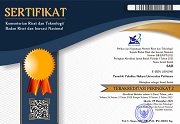Restorative Justice Arrangements in Civil Law, Common Law, and Indonesian Legal Systems
 ), Wishnu Agung Baroto(2), Valentino Dinatra Soplantila(3)
), Wishnu Agung Baroto(2), Valentino Dinatra Soplantila(3)
(1) Faculty of Law, Universitas Halmahera, Tobelo, Indonesia

(2) Department of Social and Human Science, Institute of Science Tokyo, Tokyo, Japan

(3) Faculty of Law, Birmingham University, Birmingham, United Kingdom

 Corresponding Author
Corresponding Author
Abstract
Introduction: This article will outline how the application of restorative justice in the civil law system, the common law system, and the Indonesian legal system compares.
Purposes of the Research: This study aims to provide a comprehensive comparison of the regulation and implementation of restorative justice across three legal systems - civil law, common law, and Indonesia’s hybrid legal system - and to identify best practices and challenges that can inform the development of restorative justice in diverse legal contexts.
Methods of the Research: The study uses a normative legal method, combining a legal concept approach to examine the philosophical and ethical foundations of restorative justice with a statutory approach to analyze formal legal mechanisms. This methodology links legal theory with practice while highlighting the integration of normative principles within Indonesia’s socio-cultural context, including Pancasila and customary law.
Results of the Research: This study compares restorative justice implementation in civil law, common law, and Indonesia’s legal system. Civil law is rigid and procedural, while common law allows flexible mechanisms such as victim–offender mediation. In Indonesia, despite Supreme Court Rule Number 1 of 2024, challenges include limited understanding among law enforcement, inconsistent application, and insufficient institutional support. Strengthening implementation requires harmonized regulations, professional training, community-based mechanisms rooted in local wisdom and customary law, and public awareness. Indonesia’s model highlights a transformative approach that integrates restorative principles with national values of humanity, justice, and social harmony.Keywords
DOI
10.47268/sasi.v31i4.3270
Published
2025-11-12
How To Cite
@article{SASI3270,
author = {Lilian Apituley and Wishnu Baroto and Valentino Soplantila},
title = {Restorative Justice Arrangements in Civil Law, Common Law, and Indonesian Legal Systems},
journal = {SASI},
volume = {31},
number = {4},
year = {2025},
keywords = {Restorative Justice; Civil Law; Common Law; Indonesian Legal System.},
abstract = {Introduction: This article will outline how the application of restorative justice in the civil law system, the common law system, and the Indonesian legal system compares.Purposes of the Research: This study aims to provide a comprehensive comparison of the regulation and implementation of restorative justice across three legal systems - civil law, common law, and Indonesia’s hybrid legal system - and to identify best practices and challenges that can inform the development of restorative justice in diverse legal contexts.Methods of the Research: The study uses a normative legal method, combining a legal concept approach to examine the philosophical and ethical foundations of restorative justice with a statutory approach to analyze formal legal mechanisms. This methodology links legal theory with practice while highlighting the integration of normative principles within Indonesia’s socio-cultural context, including Pancasila and customary law.Results of the Research: This study compares restorative justice implementation in civil law, common law, and Indonesia’s legal system. Civil law is rigid and procedural, while common law allows flexible mechanisms such as victim–offender mediation. In Indonesia, despite Supreme Court Rule Number 1 of 2024, challenges include limited understanding among law enforcement, inconsistent application, and insufficient institutional support. Strengthening implementation requires harmonized regulations, professional training, community-based mechanisms rooted in local wisdom and customary law, and public awareness. Indonesia’s model highlights a transformative approach that integrates restorative principles with national values of humanity, justice, and social harmony.},
issn = {2614-2961}, pages = {374--389} doi = {10.47268/sasi.v31i4.3270},
url = {https://fhukum.unpatti.ac.id/jurnal/sasi/article/view/3270}
}
an Von Hirsch, Julian V. Robert, and Anthony Bottom. Restorative Justice and Criminal Justice, n.d.
Anaris, Pradana Aditya, and Santoso Bambang. “Peraturan Restorative Justice Dalam Peraturan Mahkamah Agung No.1 Tahun 2024.” Verstek 13, no. 1 (2025): 272–77. https://doi.org/10.20961/jv.v13i2.92071.
Apituley, Lilian Gressthy Florencya, and Sri Wiyanti Eddyono. “Women and Violence In Hibualamo Traditions (An Analysis of Restorative Justice in Resolving Casses of Domestic Violence).” SASI 28, no. 3 (October 2022): 369. https://doi.org/10.47268/sasi.v28i3.972.
Bias, Self-selection, Jiska Jonas-van Dijk, Sven Zebel, Jacques Claessen, and Hans Nelen. “Victim – Offender Mediation and Reduced Reoffending : Gauging The,” 2020. https://doi.org/10.1177/0011128719854348.
Braithwaite, John. “Restorative Justice and a New Criminal Law of Substance Abuse.” Youth and Society 33, no. 2 (2001): 227–48. https://doi.org/10.1177/0044118X01033002005.
Collins, Sean P, Alan Storrow, Dandan Liu, Cathy A Jenkins, Karen F Miller, Christy Kampe, and Javed Butler. “Victims of Crime Research Digest,” 2021, 167–86.
Dainow, Joseph. “The Civil Law and the Common Law: Some Points of Comparison.” The American Journal of Comparative Law 15, no. 3 (1966): 419. https://doi.org/10.2307/838275.
Daly, Kathleen. “Conferencing in Australia and New Zealand: Variations, Research Findings, and Prospects.” Restorative Justice for Juveniles : Conferencing, Mediation and Circles, 2014. https://doi.org/10.5040/9781472559111.ch-004.
———. “Restorative Justice: The Real Story.” Punishment & Society 4, no. 1 (2002): 55–79. https://doi.org/10.1177/14624740222228464.
Entah, Aloysius R. “Indonesia : Negara Hukum Yang Berdasarkan Pancasila.” Seminar Nasional Hukum, 2016.
“European University Institute, Florence Department of Law Eui Working Paper Law No. 2002/13 Deep Level Comparative Law.” Comparative and General Pharmacology, 2002.
Fernandez, Bona, Martogi Tua, Alvi Syahrin, and Madiasa Ablisar. “Juridical Review of Comparative Prosecution Systems in Indonesia and the United States of Prosecutors Based on Restorative Justice” 642, no. Icoposdev 2021 (2022): 85–91.
frida, and Usman. “Keadilan Restoratif (Restoratif Justice) Dalam Sistem Peradilan Pidana.” Jakarta Timur : Sinar Grafika, 2024.
Hadi, Syofyan. “Mengkaji Sistem Hukum Indonesia (Kajian Perbandingan Dengan Sistem Hukum Lainnya).” DiH: Jurnal Ilmu Hukum 12, no. 24 (August 2016): 164–72. https://doi.org/10.30996/dih.v12i24.2244.
Hirsch, Andrew von, Andrew Ashworth, and Clifford Shearing. “Specifying Aims and Limits for Restorative Justice: A ‘Making Amends’ Model?*.” Restorative Justice and Criminal Justice: Competing or Reconcilable Paradigms?, 2003, 21–41. https://doi.org/10.2139/ssrn.2799216.
Hoecke, Mark Van. “Methodology of Comparative Legal Research.” Recht En Methode in Onderzoek En Onderwijs, 2016, 279–301. https://doi.org/10.5553/rem/.000010.
Hotma Situmorang Sinaga. “Implementation of Restorative Justice in Indonesian General Courts (Based on the Decree of the Director-General of the Supreme Court of the Republic of Indonesia.” International Journal of Research - Granthaalayah 9, no. 7 (2021): 1–8. https://doi.org/10.7821/granthaalayah.v9.i4.2021.3886.
I Made Artana, Tomi Apra Santosa, Ahmad Aswar Roa, and Andi Bustamin Daeng. “Pena Justisia: Restorative Justice Approaches in Criminal Law: Effectiveness and Societal Perceptions in Contemporary Legal Systems” 22, no. 1 (2025): 885–99.
Jennifer J. Llewellyn. “New Directions in Restorative Justice.” New Directions in Restorative Justice, 2013. https://doi.org/10.4324/9781843926429.
Marshall, Tony. Restorative Justice: An Overview. London: Home Office Research Development and Statistics Directorate, 1999.
Merryman, John Henry, David Scott Clark, and John Owen Haley. The Contemporary Civil Law Tradition: Europe, Latin America, and East Asia. (No Title), 2015.
Muti’ah, Dewi, Firda Laily Mufid, and Erma Rusdiana. “Legal Certainty in Settlement of Criminal Cases through Restorative Justice.” SHS Web of Conferences 149 (2022): 03019. https://doi.org/10.1051/shsconf/202214903019.
Razuni, Ganjar. “Studi Kritis Atas Pemikiran Notonagoro Tentang Pancasila Sebagai Dasar Negara.” Populis : Jurnal Sosial Dan Humaniora 9, no. 1 (2024): 62–78. https://doi.org/10.47313/pjsh.v9i1.3663.
Rochaeti, Nur, Mujiono Hafidh Prasetyo, Umi Rozah, and Jihyun Park. “A Restorative Justice System in Indonesia: A Close View from the Indigenous Peoples’ Practices.” Sriwijaya Law Review 7, no. 1 (2023): 87. https://doi.org/10.28946/slrev.vol7.iss1.1919.pp87-104.
Romero-Seseña, Pablo. “Framing European National Policies on Restorative Justice: A Frame Analysis Approach.” International Criminology 5, no. 1 (2025): 115–27. https://doi.org/10.1007/s43576-025-00161-9.
Sitanggang, Riama Manuella. “Pancasila Sebagai Ideologi Negara Landasan Implementasi Dan Relevansi Di Era Modern.” Jurnal Ilmiah Kutei 23, no. 2 (2024): 277–86.
Trenczek, Thomas. “Victim-Offender Mediation in Germany – ADR Under the Shadow of the Criminal Law?” Bond Law Review 13, no. 2 (2001). https://doi.org/10.53300/001c.5377.
Tsurayya Istiqamah, Destri. “Analisis Nilai Keadilan Restoratif Pada Penerapan Hukum Adat Di Indonesia.” Veritas et Justitia 4, no. 1 (2018): 201–26. https://doi.org/10.25123/vej.2914.
Umbereit, Mark. “Implications for Crime Victims.” U.S. Department of Justice Office of Justice Programs Office for Wctzmv of Crime, 2000, 1–23.
Undang-Undang Republik Indonesia, No 11 Tahun 2012 Tentang Sistem Peradilan Pidana Anak, n.d.
United Nations. The Bangkok Rules - Unodc, 2025.
“Universidade Do Estado Do Rio de Janeiro Centro de Ciências Sociais Faculdade de Direito Antonio Do Passo Cabral Coisa Julgada Dinâmica : Limites Objetivos e Temporais . Entre Continuidade , Mudança e Transição de Posições Processuais Estáveis Rio de Jane,” 2012.
Wada, Fauziah Hamid, YosebFerdinan Pertiwi, AnnaHasiolan, Mara Imbang SatriawanLestari, SriSudipa, I Gede IwanPatalatu, Jonherz StenllyBoari, and ErlinAbd. Rahman Puspitaningrum, JayantiIfadah. Buku Ajar Metodologi Penelitian. Cv Science Techno Direct, 2024.
Widyawati, Anis, Pujiyono Pujiyono, Nur Rochaeti, Genjie Ompoy, and Nurul Natasha Binti Muhammad Zaki. “Urgency of the Legal Structure Reformation for Law in Execution of Criminal Sanctions.” Lex Scientia Law Review 6, no. 2 (December 2022): 327–58. https://doi.org/10.15294/lesrev.v6i2.58131.
Wood, William R., Masahiro Suzuki, and Hennessey Hayes. Restorative Justice in Youth and Adult Criminal Justice. Oxford Research Encyclopedia of Criminology and Criminal Justice, 2022. https://doi.org/10.1093/acrefore/9780190264079.013.658.
Zehr, Howard. “The Little Book of Restorative Justice.” The Little Book of Restorative Justice, 2003.
Zulfa, Eva Achjani. “Restorative Justice in Indonesia: Traditional Value.” Indonesia Law Review 1, no. 2 (2011): 33. https://doi.org/10.15742/ilrev.v1n2.81.| Dublin Core | PKP Metadata Items | Metadata for this Document | |
| 1. | Title | Title of document | Restorative Justice Arrangements in Civil Law, Common Law, and Indonesian Legal Systems |
| 2. | Creator | Author's name, affiliation, country |
Lilian Gressthy Florencya Apituley; Faculty of Law, Universitas Halmahera, Tobelo; Indonesia  |
| 2. | Creator | Author's name, affiliation, country |
Wishnu Agung Baroto; Department of Social and Human Science, Institute of Science Tokyo, Tokyo; Japan  |
| 2. | Creator | Author's name, affiliation, country |
Valentino Dinatra Soplantila; Faculty of Law, Birmingham University, Birmingham; United Kingdom  |
| 3. | Subject | Discipline(s) | |
| 3. | Subject | Keyword(s) | Restorative Justice; Civil Law; Common Law; Indonesian Legal System. |
| 4. | Description | Abstract | Introduction: This article will outline how the application of restorative justice in the civil law system, the common law system, and the Indonesian legal system compares.Purposes of the Research: This study aims to provide a comprehensive comparison of the regulation and implementation of restorative justice across three legal systems - civil law, common law, and Indonesia’s hybrid legal system - and to identify best practices and challenges that can inform the development of restorative justice in diverse legal contexts.Methods of the Research: The study uses a normative legal method, combining a legal concept approach to examine the philosophical and ethical foundations of restorative justice with a statutory approach to analyze formal legal mechanisms. This methodology links legal theory with practice while highlighting the integration of normative principles within Indonesia’s socio-cultural context, including Pancasila and customary law.Results of the Research: This study compares restorative justice implementation in civil law, common law, and Indonesia’s legal system. Civil law is rigid and procedural, while common law allows flexible mechanisms such as victim–offender mediation. In Indonesia, despite Supreme Court Rule Number 1 of 2024, challenges include limited understanding among law enforcement, inconsistent application, and insufficient institutional support. Strengthening implementation requires harmonized regulations, professional training, community-based mechanisms rooted in local wisdom and customary law, and public awareness. Indonesia’s model highlights a transformative approach that integrates restorative principles with national values of humanity, justice, and social harmony. |
| 5. | Publisher | Organizing agency, location | Faculty of Law, Universitas Pattimura |
| 6. | Contributor | Sponsor(s) | |
| 7. | Date | (YYYY-MM-DD) | 2025-11-12 |
| 8. | Type | Status & genre | Peer-reviewed Article |
| 8. | Type | Type | |
| 9. | Format | File format | |
| 10. | Identifier | Uniform Resource Identifier | https://fhukum.unpatti.ac.id/jurnal/sasi/article/view/3270 |
| 10. | Identifier | Digital Object Identifier | 10.47268/sasi.v31i4.3270 |
| 11. | Source | Title; vol., no. (year) | SASI; Volume 31 Issue 4, December 2025 |
| 12. | Language | English=en | en |
| 13. | Relation | Supp. Files | |
| 14. | Coverage | Geo-spatial location, chronological period, research sample (gender, age, etc.) | |
| 15. | Rights | Copyright and permissions | Copyright: Authors who publish their manuscripts in this Journal agree to the following conditions: 1. The copyright in each article belongs to the author, as well as the right to patent. 2. Authors can enter into separate, additional contractual arrangements for the non-exclusive distribution of the journal's published version of the work (e.g., post it to an institutional repository or publish it in a book), with an acknowledgment of its initial publication in this journal. 3. Authors are permitted and encouraged to post their work online (e.g., in institutional repositories or on their website) before and during the submission process, as it can lead to productive exchanges, as well as earlier and greater citation of published work. 4. Authors have the right to self-archiving of the article (Author Self-Archiving Policy)
License: The SASI Journal is disseminated based on the Creative Commons Attribution-NonCommercial 4.0 International license terms. This license allows anyone to copy and redistribute this material in any form or format, compose, modify, and make derivatives of this material for any purpose. You cannot use this material for commercial purposes. You must specify an appropriate name, include a link to the license, and certify that any changes have been made. You can do this in a way that is appropriate but does not imply that the licensor supports you or your use.
|
Copyright (c) 2025 Lilian Gressthy Florencya Apituley, Wishnu Agung Baroto, Valentino Dinatra Soplantila

This work is licensed under a Creative Commons Attribution-NonCommercial 4.0 International License.

 : 492 times
: 492 times Download : 379 times
Download : 379 times
















